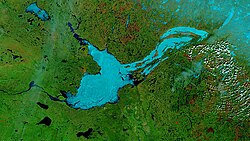Great Slave Lake
Great Slave Lake (French: Grand lac des Esclaves) is the second-largest lake in the Northwest Territories of Canada. It is the deepest lake in North America at 614m,[1] and the ninth-largest lake in the world. It is 480 kilometres (300 mi) long and 19 to 109 kilometres (12 to 68 mi) wide. It covers 27,200 square kilometres (10,502 sq mi).[1] The lake shares its name with the Slavey First Nations. Towns on the lake include: Yellowknife, Hay River, Behchoko, Fort Resolution, Lutselk'e, Hay River Reserve, Dettah and N'Dilo.
| Great Slave Lake | |
|---|---|
 False-color photo of Great Slave Lake | |
 Map of Great Slave Lake and Lake Athabasca | |
| Location | Northwest Territories |
| Coordinates | 61°40′N 114°00′W / 61.667°N 114.000°W |
| Type | remnant of a vast glacial lake |
| Primary inflows | Hay River, Slave River |
| Primary outflows | Mackenzie River |
| Catchment area | 971,000 km2 (374,905 sq mi)[1] |
| Basin countries | Canada |
| Max. length | 480 km (300 mi)[source?] |
| Max. width | 109 km (68 mi)[source?] |
| Surface area | 27,200 km2 (10,502 sq mi)[1] |
| Average depth | 41 m (135 ft)[1] |
| Max. depth | 614 m (2,014 ft)[1] |
| Water volume | 1,580 km3 (380 cu mi)[1]/ |
| Shore length1 | 3,057 km (1,900 mi)[1] |
| Surface elevation | 156 m (512 ft)[1] |
| Frozen | November - mid June[2] |
| Settlements | Yellowknife, Hay River, Behchoko, Fort Resolution, Lutselk'e, Hay River Reserve, Dettah, N'Dilo |
| 1 Shore length is not a well-defined measure. | |
History change
North American Aboriginal Peoples were the first people to live around the lake. They built communities including Dettah, which still exists today. British fur trader Samuel Hearne explored the area in 1771 and crossed the frozen lake. He named it Lake Athapuscow. This was a misunderstanding of the name Athabaska. In 1897-1898, the American frontiersman Charles "Buffalo" Jones traveled to the Arctic Circle.
In the 1930s, gold was discovered there, and the city of Yellowknife was founded. It became the capital of the Northwest Territories. In 1967, an all-season highway was built around the lake, originally an extension of the Mackenzie Highway but now known as Yellowknife Highway or Highway 3. On January 24, 1978, a Soviet Radar Ocean Reconnaissance Satellite, named Kosmos 954 fell from orbit and broke apart. The satellite had an on board nuclear reactor. Pieces of the nuclear core fell near the Great Slave Lake. 90% of the nuclear debris was recovered by a group called Operation Morning Light. They included people from both the United States and Canada.[3]
Geography and natural history change
The Hay, Slave and Taltson Rivers enter the lake. The Mackenzie River flows out. The western shore has forests, but the east shore and northern arm are tundra-like. The southern and eastern shores reach the edge of the Canadian Shield. The Great Slave Lake remains from a large post-glacial lake along with other lakes such as the Great Bear and Athabasca.
The main western part of the lake is a bowl with a surface area of 18,500 km2 (7,100 sq mi) and a volume of 596 km3 (143 cu mi). This main portion has a maximum depth of 187.7 m (616 ft) and a mean depth of 32.2 m (106 ft).[4] To the east, McLeod Bay (62°52′N 110°10′W / 62.867°N 110.167°W) and Christie Bay (62°32′N 111°00′W / 62.533°N 111.000°W) are much deeper, with a maximum recorded depth in Christie Bay of 614 m (2,014 ft).[1]
There is the nesting site of a flock of Whooping Cranes south of Great Slave Lake, in a remote corner of Wood Buffalo National Park.[5]
Ice road change
There is one ice road on Great Slave Lake. It connects Yellowknife to Dettah.
Related pages change
References change
- ↑ 1.00 1.01 1.02 1.03 1.04 1.05 1.06 1.07 1.08 1.09 Hebert, Paul (2007). "Great Slave Lake, Northwest Territories". Encyclopedia of Earth. Washington, DC: Environmental Information Coalition, National Council for Science and the Environment. Retrieved 2007-12-07.
- ↑ Canada Flight Supplement's Water Aerodrome Supplement Archived 2007-10-25 at the Wayback Machine. Effective 0901Z 12 March 2009 to 0901Z 11 March 2010
- ↑ Natural Resources Canada. "Operation Morning Light". Archived from the original on 2011-09-29. Retrieved 2007-01-24.
- ↑ Schertzer, W. M. (2000). "Digital bathymetry of Great Slave Lake". NWRI Contribution No. 00-257, 66 pp.
{{cite journal}}: Cite journal requires|journal=(help) - ↑ University of Nebraska (February 1982). "Whooper Recount". Papers in Ornithology. Retrieved 2007-01-20.
Further reading change
- Canada. (1981). Sailing directions, Great Slave Lake and Mackenzie River. Ottawa: Dept. of Fisheries and Oceans. ISBN 0660110229
- Gibson, J. J., Prowse, T. D., & Peters, D. L. (2006). Partitioning impacts of climate and regulation on water level variability in Great Slave Lake. Journal of Hydrology. 329 (1), 196.
- Hicks, F., Chen, X., & Andres, D. (1995). Effects of ice on the hydraulics of Mackenzie River at the outlet of Great Slave Lake, N.W.T.: A case study. Canadian Journal of Civil Engineering. Revue Canadienne De G̐ưenie Civil. 22 (1), 43.
- Kasten, H. (2004). The captain's course secrets of Great Slave Lake. Edmonton: H. Kasten. ISBN 097366410X
- Jenness, R. (1963). Great Slave Lake fishing industry. Ottawa: Northern Co-ordination and Research Centre. Dept. of Northern Affairs and National Resources.
- Keleher, J. J. (1972). Supplementary information regarding exploitation of Great Slave Lake salmonid community. Winnipeg: Fisheries Research Board, Freshwater Institute.
- Mason, J. A. (1946). Notes on the Indians of the Great Slave Lake area. New Haven: Published for the Department of Anthropology, Yale University, by the Yale University Press.
- Sirois, J., Fournier, M. A., & Kay, M. F. (1995). The colonial waterbirds of Great Slave Lake, Northwest Territories an annotated atlas. Ottawa, Ont: Canadian Wildlife Service. ISBN 0662238842
Other websites change
- Great Slave Lake pictures Archived 2012-07-18 at the Wayback Machine from Picsearch.com